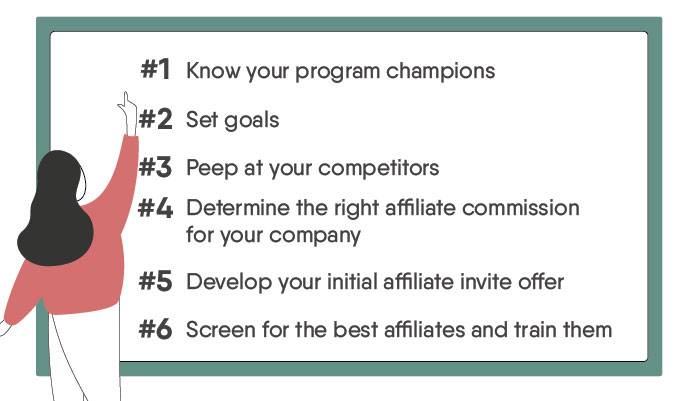Here is Your Checklist For a Profitable Affiliate Marketing Program
Affiliate marketing has grown quickly since its inception.
The e-commerce website, viewed as just another marketing channel in the early days of the Internet, quickly became the centrepiece of overall business strategy as it leveraged the scalability of sales to outdo traditional brick-and-mortar stores.
Affiliate marketing has allowed businesses of all sizes to access a larger market, drive website traffic, and increase sales. It has also provided a platform for smaller businesses to compete with larger businesses by offering a more level playing field in terms of reach and opportunity.
This study from MarketingSherpa’s research team estimated that, in 2006, affiliates worldwide earned US$6.5 billion in bounty and commissions from various sources in retail, personal finance, gaming and gambling, travel, telecom, education, publishing, and forms of lead generation other than contextual advertising programs.
From this, it’s clear that once your product or service is marketing and worth the reward, your advocates are happy to do the hard work of getting the word out. Now, let’s reverse-engineer the art behind some of the best affiliate marketing programs that have rocked the marketing world. But first, the basics:
What is Affiliate Marketing?
Affiliate marketing (also known as “performance marketing”) is a performance-based marketing strategy where businesses reward affiliates — someone who has agreed to promote a company’s products or services in exchange for a commission on any resulting sales — for each customer won by the affiliate’s own marketing efforts.
This way, an affiliate marketer earns a commission every time they drive traffic or sales to your company through their own marketing effort, which can take the form of blog posts, social media posts, paid ads, or even word-of-mouth marketing.
The affiliate marketing industry has four core players: the merchant (also known as ‘retailer’ or ‘brand’), the network (that contains offers for the affiliate to choose from and also takes care of the payments), the publisher (also known as ‘the affiliate’), and the customer.
When you begin your affiliate program, you’ll give those who sign up to be affiliates access to your products, services, or offers. These affiliates may then:
- Promote your products or services using affiliate links in blog posts or other forms of content.
- Share product reviews online.
- Inform their warm audience about the products, services, or offers via e-mail marketing, forums, podcasts, and other online platforms.
Your company can identify which affiliate a lead or sale is from by using a dedicated affiliate platform to handle its affiliate marketing program. Once the lead or sale comes from the affiliate’s unique tracking code, the person qualifies for the commission you’ve committed to paying them.

Affiliate marketing vs. influencer marketing vs. referral marketing
People often use affiliate marketing, influencer marketing, and referral marketing interchangeably, but there are a few key differences in their models. Here’s the rundown:
Influencer marketing
Like affiliate marketing, influencer marketing is a revenue-generating strategy available to individuals outside your business. Namely, celebrities or influential people, drawing from their large pool of social media following to advertise your products.
The secret sauce of influencer marketing is the reach and impact of these celebs on social media. Their promotion or endorsement of a product, service, or event covers more ground, boosting brand awareness, which means more people are likely to convert.
Referral marketing
Referral marketing programs involve a model that promotes products or services to new customers through referrals, usually word-of-mouth. A referral-based marketing strategy is worth considering if you cannot pay cash commissions on each sale, if your product targets a specific niche, or if you haven’t quite made a name in your market.
All three types of marketing can be effective, but it’s important to understand the difference for an effective strategy.
Do you want to drive sales? Then affiliate marketing might be the way to go. Do you want to build relationships and create awareness? Then influencer marketing might be the way to go. Do you want customers to come back or recommend your products/services to others? Then referral marketing might be the way to go.
It’s up to you to decide which. The right execution, though, is key. Else, you could end up wasting time and marketing budget.
How do I start on affiliate marketing?: A step-by-step guide

Know your program champions
Your program champion is someone within your organisation who’ll assume ownership of the affiliate marketing program and be responsible for directing and achieving the program’s key objectives.
For your ideal brand champion, you need someone who exhibits savvy in planning and execution of partnerships, is results-oriented, and is good at managing customer relations.
Set goals
All marketing campaigns need goals, and your affiliate program is no exception. You need first to identify your ideal affiliate audience. So, you ask two critical questions:
- “What demography of audience are we targeting with this affiliate program?”
- “What class of affiliates will help us reach them?”
The program champion will then set some measurable goals or KPIs to measure the success of your program. Of course, you’ll focus heavily on how much revenue you want to deliver every month, quarter, or year. Conversation rates are a helpful metric; how many people do you need to click on your affiliate link to make a purchase?
The Average order value or AV from affiliates and the number of unique affiliate sales per period is another metric to evaluate performance.
Peep at your competitors
After doing a SWOT analysis to learn where your business stands relative to the competition, you also need to review their affiliate marketing programs to make yours emerge even stronger. Here are a few steps to do this effectively:
- Review at least two competitors and ensure one of them has the same audience as your organisation but doesn’t directly compete with you.
- Pay attention to their commission structure.
- Examine how they find their affiliates.
- Note the terms and conditions of each competitor affiliate program and each affiliate program’s peculiarities in training, promotion, branding, tracking cookie use, etc. Spot strengths and weaknesses and use these to fortify your strategy.
Determine the right affiliate commission for your company
Here, your competitive analysis must’ve prepared you enough to structure your affiliate program. Your commission structure is one of the important elements of the process.
How will you pay your affiliates? One thing to note is this — you only compensate affiliates if a sale comes from their affiliate link. Never pay for clicks or impressions!
Important questions about affiliate payments include:
- Will you pay a fixed amount per sale or a percentage?
- Will you pay in cash or store credit?
- What or how much in commission will you offer?
- What is your entire overhead per customer and sale?
You may consider sweetening up your affiliate program by rewarding top affiliates with commission bonuses.
Develop your initial affiliate invite offer
Next on the chopping block is to find ways to attract potential marketing affiliates. A close look at specific products or categories you want to promote is a good starting point. These could be products or services with more significant margins, likely to drive stronger revenue results.
You should also consider the most compelling partnership from the affiliate’s perspective. For instance, while promoting a slow-moving product may benefit your business, affiliates may prefer something else.
You can use A/B testing to conduct such trials. This will help make the implementation process faster while ensuring that there are minimal hiccups during execution.
Screen for the best affiliates and train them
After spreading the word about your affiliate marketing program, it’s realistic to expect all comers. This leaves you needing a reliable system to sift out any phonies. Remember, you want high-quality affiliates only. Segmentation tools can help with this process.
Check out prospective affiliates’ blogs, websites, and social media profiles to see if they’re a good fit. They should also have a consistent content strategy and a concrete plan of how they’ll promote your brand once you select them. The more prior experience they have, the better for your marketing efforts.
Once you have signed agreements for each affiliate, you need a training program and an information system that keeps them in the loop about your brand. Regular training sessions help to keep affiliate relationships with your brand warm.
What is an example of affiliate marketing?
Amazon Affiliate program (also known as “Amazon Associates”):
One of the most popular and successful online affiliate programs, the Amazon Associate is completely free for website owners and bloggers to engage in. They promote Amazon.com items on their websites by using links (which drive referral traffic back to Amazon). Customers earn referral money when they click the links and purchase.
Members may earn between $100 and $20,000 on average through the Amazon Affiliate program, depending on the number of referrals. The Amazon Affiliate network works on a commission basis, which means you’ll earn a percentage of each sale.
APSIS Affiliate Program.
And what better way to give you a gentle, tap-on-the-back reminder about our affiliate program? APSIS One— a digital marketing automation solution — also leverages the affiliate marketing network for marketers, consultants, e-commerce experts, and just about anyone with a passion for digital marketing.
Using your unique referral link on your blog, banner ads, or any digital channel, you can earn recurring commissions for referring/reselling APSIS One. Got more inquiries? Here’s the lowdown of all the perks for our army of affiliates.
Automate your way to Marketing Success with APSIS One
The ability to track data and measure results has been a key advantage of affiliate marketing. It’s allowed businesses to tailor their campaigns to specific demographics, interests, and behaviour, resulting in effective and efficient use of marketing resources.
One thing is sure: automation must have a place in your affiliate marketing program. A marketing automation solution will help you boost productivity, efficiency, and campaign effectiveness with capabilities that:
- Provide insight into performance on select placements by generating specific tracking links containing advertiser references to link back to,
- Track link and sales excellently
- Manage affiliate data and report program outcomes.
With over a decade of experience helping several affiliate businesses across Europe and globally, APSIS One is loaded with a stack of digital automation and analytical tools to help you set up and create your army of digital evangelists. Prefer to see how APSIS One works for your affiliate marketing works? Book a demo here!
Find out how APSIS One is the best option for your business!






